The Canterbury Tales The General Prologue Summary & AnalysisIntroductionWe may learn more about the General Prologue by studying the Canterbury Tales summary. It describes each of the 29 individuals. These individuals are pilgrims traveling to Canterbury. We learn about the stories each relates as they go along, which is a fascinating aspect of the Canterbury Tales summary. 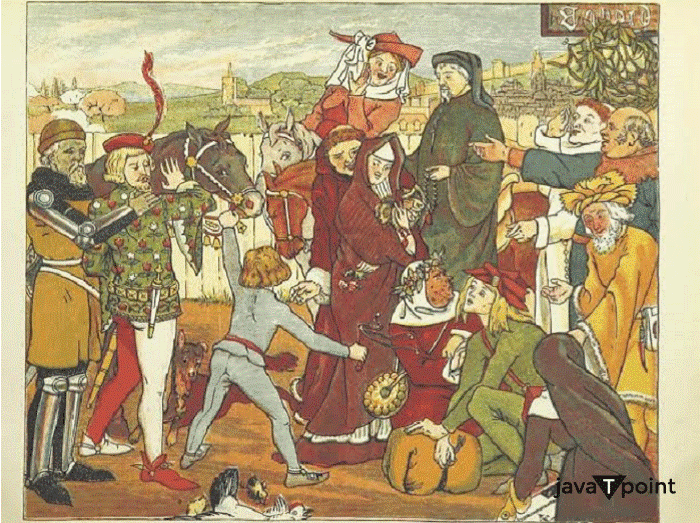
The narrator skilfully describes the pilgrims. According to their status and rank, he lists them. As a result, it is filled with intriguing tales that shed light on the personalities of several pilgrims. Additionally, it conveys to us the narrator's opinion of them. Conflicts arise due to the pilgrims' diverse personalities, and we witness the Host attempting to resolve them. ThemeIn Chaucer's lengthy poem, 31 pilgrims, including Chaucer himself, travel from Southwark's Tabard Inn to Canterbury Cathedral, where St. Thomas � Becket is venerated. To pass the time on the trip, the innkeeper proposes that each pilgrim tell two stories on the way out and another two on the way home. The best storyteller will receive a complimentary dinner when they get back. This literary approach allows Chaucer the chance to create a succession of vivid word images of a cross-section within his society, from a knight and prioress to a carpenter and cook, a much-married woman of Bath to a bawdy miller - a vocation viewed in Chaucer's day as unstable and treacherous. 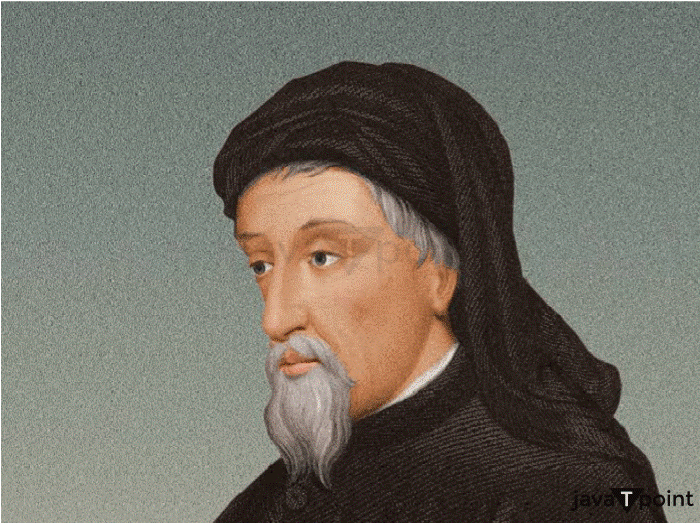
Chaucer combines realism and sarcasm to create vivid characters when describing his travellers. Their stories have a variety of tones, from serious to humorous, and their humor veers between sophisticated wit and good, clean vulgarity. Combined, the stories provide a fascinating look into life in late-fourteenth-century England. Only 24 of the nearly 100 stories that Chaucer had initially intended to write?some previously written for earlier works?were finished. The Hengwrt manuscript is most esteemed for its accuracy since various surviving versions have various orderings. In the General Prologue, Chaucer plays Latin, French, and English words off each other to demonstrate his deep understanding of literature and language. Latin was regarded as the language of learning during the Middle Ages, whereas French was seen as a hierarchical, courtly, and aristocratic language. The Canterbury Tales' opening lines display a variety of wording by combining English words for nature with French terminology for the same things?"route," "holt and heath," and "cropped"?such as "draught," "veyne," and "liquor. SummaryConcisely, the general prologue will be covered in the Canterbury Tales summary. Geoffrey Chaucer's The Canterbury Tales is divided into two parts, and the of which is titled The General Prologue. A pub outside of London is where the play begins. Several pilgrims are getting ready to travel to Canterbury to visit St. Thomas Becket's shrine. The play's narrator, Chaucer, first encounters them there. They persuade him to go along with them, and he accepts. Chaucer provides a delightful and humorous depiction of the travellers in the General Prologue of the Canterbury Tales. The Host suggests the pilgrims around dinnertime. The Host suggests the pilgrims around dinnertime. According to him, each pilgrim must share two tales on the trip to Canterbury and two more on the way back. The Host will decide whether or not to believe the stories he tells. 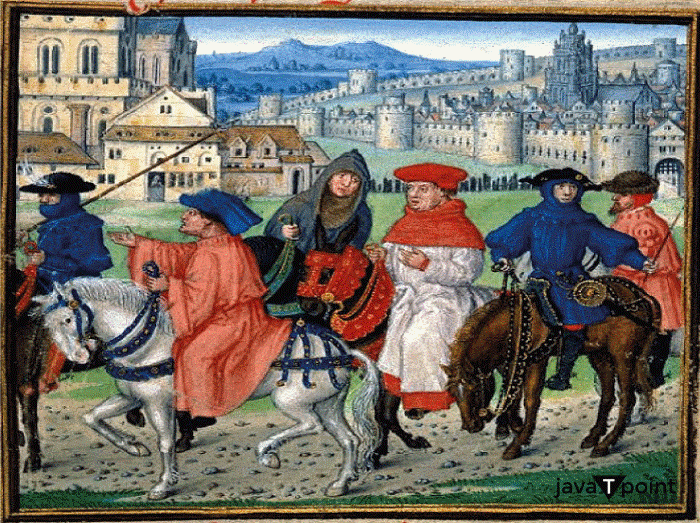
He continues by saying that the traveler with the finest narrative will receive a complimentary meal at the pub after the tour. Furthermore, he adds that anyone who challenges his decision must foot the entire pilgrimage's fee. The pilgrims are excited by this, and they unanimously accept this suggestion. Additionally, they commit to play under the game's rules. When the storytelling session starts, they leave Canterbury on horseback the following day. However, a pilgrim immediately opposes the Host's authority. The Monk is invited to tell another story after the previous one is finished, but the drunk Miller wants to move on or leave. The Host's authority is subsequently questioned in the following scenes. After all, when a drunken pilgrim and a group of mysterious strangers are together, something terrible will happen. Throughout the trek, the pilgrims tell us a variety of tales. But they soon begin insulting each other directly. For instance, the carpenter becomes insulted when Miller recounts a demeaning story about him. He fabricates a story to degrade Miller as a result. This keeps happening as the Host fights to end the cropping disputes. In contrast to the anticipated one hundred and twenty, it merely concludes after twenty-four tales. The sermon delivered by the Parson serves as the book's conclusion. It talks about sin and forgiveness and ends with Chaucer's departure. The general prologue in the Canterbury Tales summary aids in providing a comprehensive overview of the characters. This will make it easier to understand the pilgrims and their habits on a deeper level. AnalysisThe Canterbury Tales: General Prologue by Chaucer opens with the words, "Here beginneth the Book of the Tales of Canterbury." With this little statement, he consciously communicates his intended meaning. Despite having the label "tales," the artistic creation is written in poetry, a familiar genre at the time. Chaucer introduces his tale-tellers in this broad introduction, choosing them from 14th-century England due to his objectivity and creative talent. "Whan that Aprille with his shoures soote, ... That hem hath holpen whan that they were seeke." - Line 1-18 Chaucer provides a lovely depiction of April, the spring that has sparked a common emotion, in the opening verse of "The Canterbury Tales: General Prologue." The west wind carries the April Shower along with the smell, and the singing made by the little birds appears to entice the people to embark on a journey. They go to several nations in search of remote saints in foreign lands. St. Thomas, a revered martyr who served as Canterbury's Archbishop from 1162 to 1170, is sought by people from all across England who go to Canterbury. He was killed by Henry II's supporters at Canterbury Cathedral because they disagreed with him on church privileges and rights. He was declared a saint by Pope Alexander III shortly after his passing. Due to the widespread belief that he aids the ill, pilgrims from all across the nation pay him a visit out of reverence. "Bifil that in that seson on a day, ... And at a Knyght than wol I first bigynne."- Line 19-42 In the second verse, Chaucer describes his trip to Canterbury. He spent the duration of his trip at the Southwark Tabard Inn. By incident, he was joined by another 29 pilgrims traveling to Canterbury. They decided to remain there because the tavern offered plenty of rooms and roomy stables. By the end of the day, he had been acquainted with everyone, and they had united for the same goal. The poet swears he'll go off on his voyage with them the following day. Nevertheless, the poet describes the people he met that morning before starting his voyage since he had additional time to spare. "A Knyght ther was, and that a worthy man, ... And wente for to doon his pilgrimage."- Line 43-78 The Knight is the first figure Chaucer introduced in stanzas four to six of "The Canterbury Tales: General Prologue." Due to his adherence to chivalry, truth, integrity, freedom, and civility, the Knight is portrayed as a remarkable individual. In locations like Algezir, Belmarye (Benamarin), Lyeys (Ayas), and Satalye (Attalia), he had participated in multiple wars and expeditions. He had also participated in several Mediterranean naval campaigns. He has participated in around fifteen lethal wars. Furthermore, he killed all his opponents while fighting three times for his faith, Christianity. This Knight has previously fought with Palatia's ruler. The Knight is honorable and knowledgeable, yet as Chaucer writes, there is no sign of such vanity in his demeanor because he is kind and humble with his friends. 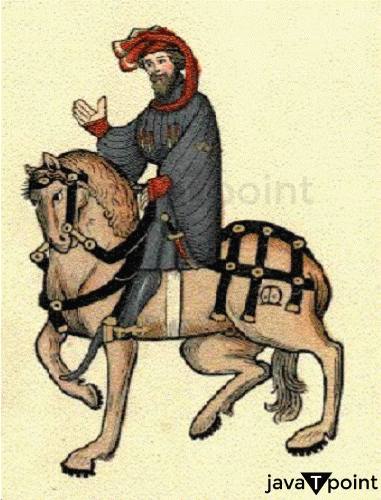
The sixth stanza of Chaucer's poem is a description of his attire. Although he arrived on a beautiful horse, he wasn't attired in the typical way knights would. He was dressed in a doublet made of fustian, a coarse fabric that was black, discolored, and marked by his armor. After returning home after his military, it appeared he had come immediately to make his pilgrimages. "With hym ther was his sone, a yong Squi�r, ... And carf biforn his fader at the table."- Line 79-100 The young squire that followed the Knight on his trip was his son, described by Chaucer. He is a happy bachelor around the age of twenty, with curly hair that seems like it was straightened in a press. Although he was only moderately tall, he had his father's excellent physical attributes of strength and quickness. He had formerly deployed with the cavalry and behaved heroically at Flaundres (Flanders), Artoys (Artios), and Pycar dye (Picardy). He was dressed in an intricately embroidered gown that appeared to be a meadow covered with vibrant red and white flowers. Like the new May flowers, he constantly sang or fluttered, giving off a fresh aspect. He appeared to be a gifted young man since he could compose music, recite poetry, compete in a fight with dance, and paint and write effectively. He was such a passionate love for his wife that at night he could rest like a nightingale. Moreover he was also courteous, meek, and humble, much like his father (the Knight), and was cut to assist his father during the meal. "A Yeman hadde he and serv�ntz namo ... A forster was he, soothly as I gesse."- Line 101-117 In verse eight of the poem, Chaucer mentions the yeoman the Knight brought with him. The yeoman was dressed in a green coat and hood. He had a sheaf of colorful, accurate peacock arrows properly stowed behind his belt. Also had a dagger on the other that was as sharp as a spear. He presented himself as a yeoman while holding a mighty bow. Additionally he wore a sassy brace on his arms to protect them from the bowstrings. He was sporting a shiny silver St. Christopher medal, regarded as the patron saint of travelers, on his breast. Chaucer claims that he may have been a forester because he was wearing a green belt and carrying a hunting horn. 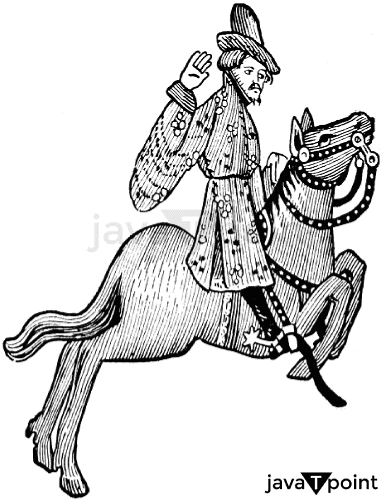
"Ther was also a Nonne, a Prioresse, ... That was hire chapeleyne, and Preestes thre."-Line 119-163 In line 119, Chaucer describes the Knight and his comrades; in these lines, he shifts his focus to religious figures. A second nun, her chaplain, three priests, and the prioress are traveling together. Madam Eglantine was a modest and humble woman. Additionally, they spoke Stratford-atte-Bowe French, not the French used in Paris. She was also exceptionally well taught in table etiquette since neither she nor her fingers ever let a bite slip from their lips or dipped them too far into the sauce. Despite being a nun, she seemed to have a particular flair for politeness and tried to come off as someone of importance. She presented a dignified persona in all her dealings and showed genuine feelings and sympathy. 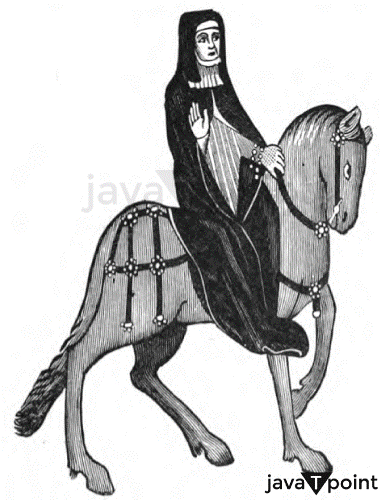
She had lovely and exquisite features, including grey eyes, a sophisticated nose, small yet supple lips, and red. Her veils were delicately pleated, and she also donned a chic cloak. She wore a set of coral beads, a coral charm, an elegant golden brooch with the Latin words "Amor vincit omnia" and a crowned 'A' inscribed on it hanging from her arm. "A Monk ther was, a fair for the maistrie, ... His palfrey was as broun as is a berye." -Line 164-206 The Monk set the standards for fashion. He had a strong interest in hunting and farming and had also kept a large number of horses at his stables. His bridle had a chapel bell-like chime when he rode. Because he considered them outdated and stringent, the Monk disregarded the old regulations of St. Maur or St. Benet. He followed the contemporary wide path and never paid attention to the passages claiming hunters aren't holy people or monks who spend time beyond the cloister are like fish outside the water. Even though he is a monk, he chooses to ignore all of the saints' advice and ride aggressively. He also possessed dogs that could run as fast as birds. The best fur in the country covered everything on his body, even his sleeves. A stylish gold pin has secured his hood beneath his chin. He had a bald head, a glowing visage, and was an impressively large priest. His blazing eyes appeared like a lead furnace as they spun in his head. He was mounted on a lovely horse that was as brown as a plum and had soft boots. Because of this, Chaucer observes that he would unquestionably pass for a regal bishop, given his look. He did not, in any way, resemble the tormented soul that is typically associated with a monk. "A Frere ther was, a wantowne and a merye, ... This worthy lymytour was cleped Hub�rd."- Line 207 -270 The "Friar" is the second person Chaucer presents to us in "The Canterbury Tales: General Prologue." The friar is an outrageously happy man. He is a man of celebration and limits. There isn't a single member of the three Augustinian, Franciscan, or Dominican orders who is familiar with flattery. He appears well-liked by affluent ladies in the community and the Franklin family. He possessed a unique authorization from the Pope and was competent to hear confessions. He made absolute statements and heard admissions with pleasure. Considering that he had a good income from it, he was a man who was simple to make amends for. He could play the harp and sing and had a cheery voice. Despite being respectable, he knew more bartenders and innkeepers than lepers or beggar women. He was amicably courteous when serving the underprivileged in the prosperous location, ensuring he received a farthing despite the fact he could not receive a penny. As a result, he earned significantly more money than he did at his regular job. As stated by Chaucer, his name is "Hub�rd." "A Marchant was ther with a forked berd, ... But, sooth to seyn, I noot how men hym calle." -Line 271-285 Chaucer presents the merchant, a figure that serves as a metaphor for those in commerce, after the figures from the church. The merchant was perched high atop a horse, wearing a riotous outfit and a forking beard. He was wearing a Flemish beaver cap. His boots were laced fairly and tidily. Using a somber tone, he made his points while constantly mentioning his rising profit. In addition, he underlined his concern regarding protecting the sea from any hostile acts between Middleburg and Orwell. He successfully handled his difficulties by using his intelligence to his advantage. Although Chaucer believes him to be a good guy, he is curious about how others would feel. "A Clerk ther was of Oxenford also, ... And gladly wolde he lerne and gladly teche." -Line 286-310 We will now examine a scholarly guy, an Oxford "clerk," in this stanza of "The Canterbury Tales: General Prologue." He rode a horse that appeared to be as slim as a rake and was a male who had mastered reasoning. Even though he wasn't overweight, he appeared self-controlled and gaunt. Additionally, he wore a plain outfit. He often gave the impression of a guy who chose to live a modest life surrounded by literature over one that was rich with trinkets and flashy clothing. He had very little gold in his safe, even though he was a philosopher. Nevertheless, he prayed for the salvation of people who gave him money to pay for his education. It was clear that his time was spent studying more than anything else. He hasn't talked as much as his other friends have. Even then, he talked with respect and decorum. Additionally, he talked in brief, animated bursts with lofty, virtue-filled sentences. Overall, he gave off the impression of being a man who would be genuinely happy to teach and learn. "A Sergeant of the Lawe, war and wys, ... Of his array telle I no lenger tale."- Line 311-333 Now Chaucer turns his focus to the wise and prominent lawyer. The attorney seems to have frequented St. Paul's, where attorneys frequently congregate. He was wise and had a lot of dignity since he spoke so intelligently. Given his experience and reputation, it appears he was a court of assizes judge appointed by the monarch. He made a good living each year, which he used to purchase land. He was also quite busy since he kept track of every case's account for which he offered solutions in his yearbook. Additionally, he was skilled at creating legal documents, allowing him to write without errors. In fact, he knew every piece of legislation off-by-heart. Despite this, he wore a plain, multi-coloured coat belted with a silk belt with thin stripes. With his extensive knowledge and unassuming exterior, Chaucer creates a singular contrast. 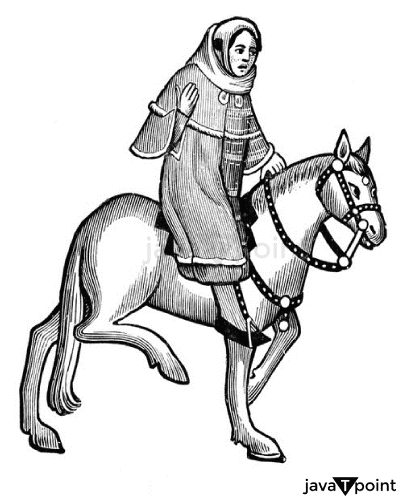
"A Frankeleyn was in his compaignye. ... Was nowher such a worthy vavasour." -Line 334-364 Franklin, a guy with a beard as white as a delicate lily and a sense of humor, was one of the Chaucer's company's Frankeleyns. He cherished dipping his toast in wine in the morning. He enjoys life since he is the son of Epicurus, the scholar, and philosopher who created Epicureanism, according to Chaucer. Due to his outstanding domestic skills, Saint Julian was revered throughout his nation as the patron saint of hospitality. His home is well-stocked with wine, and always enough freshly made pies, seafood, and meat are available. His hospitality is well-known. According to the season, he adjusted his dinner and noon meal because he was independent and had the freedom to do so. And in his fish pond, he kept many bream, pike, and partridges in pens. Anybody in need might eat at his table, which was set up all day. Furthermore, he frequently served as a member of parliament and ruled over court proceedings as Lord and Sire. He had also served as a tax auditor and a sheriff. He wore a belt made of silk that was as white as morning milk, and he carried a dagger and a pocketbook. Chaucer notes at the end of his depiction that "Was nowhere switch a worthy vavasor"?no one could find a more deserving landowner anywhere?no one could find one like him. "An Haberdasshere, and a Carpenter, ... And have a mantel roialliche y-bore." -Line 365-383 They employed carpenters, weavers, dyers, tapestry makers, haberdashers, and other working-class members. They were all dressed in the serious, imposing parish guild uniform. They had brand-new decorations on their equipment, and their blades were also made of silver. Their belts and handbags demonstrated they were respectable citizens who could sit on the dais in a municipal hall. Each had sufficient wealth and money to serve as an alderman. In the absence of such women, they would have been held accountable. Their wives were worthy and successful partners. Being addressed as "my lady" and attending feasts on festival eves while leading the procession and having a gown carried in a regal manner was an honor. "A Cook they hadde with hem for the nones, ... For blankmanger, that made he with the beste." - Line 384-393 To assist them in cooking the chicken with marrowbones and spices, the Guildsmen brought a cook with them. The cook is an accomplished chef because he could tell the London ale apart just on flavor. He was adept in roasting, seething, boiling, and frying. He could also bake a delicious pie and cook a hearty soup. He could create minced capon using milk, sugar, and flour, among other top components, but unfortunately, he possessed an open shore on his shin. 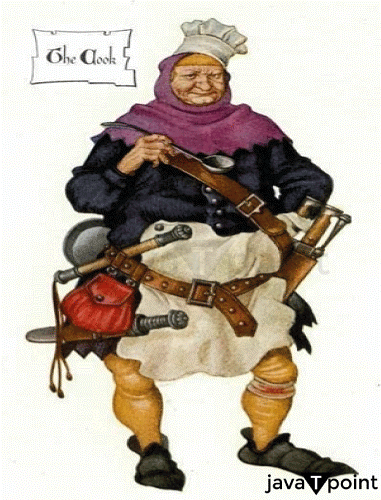
"A Shipman was ther, wonynge fer by weste; ... His barge y-cleped was the Maudelayne." -Line 394-411 One of the pilgrims included a shipman who may have been from Dartmouth and came from a far-off western region. He rode a farmer's horse as far as possible to keep pace with his other travelers. He dressed in coarse garments that reached his knees. A dagger was suspended on a thread from his neck, beneath his arm, and down. The long, scorching summer appeared to have given him a brownish tan. Though he had purchased wine from the merchant while asleep and had done it without regard for his conscience, Chaucer still refers to him as a decent man. There was, however, no one from Hull to Cartagena (Spain) who could match him in terms of his navigational skills and ability to calculate tides, currents, impending dangers, the harbor, the position of the moon, and other factors. His extensive knowledge of every port, from Gottland to the Cape of Finistere, and every watercourse in Britain and Spain. According to Chaucer, the Maudelayne is the name of the ship the shipman is on. "With us ther was a Doctour of Phisik; ... Therfore he lovede gold in special."- Line 412-445 A doctor of medicine named Doctour of Phisik, who was unmatched by him in both surgery and medicine traveled with them. He has had a good education in astronomy as well. He understood the root of every illness since he was an expert practitioner. When he discovers the illness, he immediately offers the cure. The medication he would recommend that they keep on hand at all times was known to all of his apothecaries. They both profit from each other's cunning, says Chaucer. The poet claims to have an abnormal passion for material gain and only sometimes peruses the Bible. He keeps his profit in gold since he has a particular fondness for it. "A Good Wif was ther of biside Bathe, ... For she koude of that art the olde daunce."- Line 446-477 Chaucer leads his readers on a trip to comprehend the "Wife of Bath" persona after the medical expert. It is frequently regarded as Chaucer's masterpiece. She appears to be a respected societal woman, yet she struggles with hearing. Her weaving abilities were superior to many of the Ypres and Ghent weavers. She also enjoyed making her offering before any other parishioner woman could. Also wore a handkerchief that might weigh up to 10 pounds in Chaucer's exaggerated version. She wore soft and brand-new shoes, and her stockings were also a wonderful crimson red. 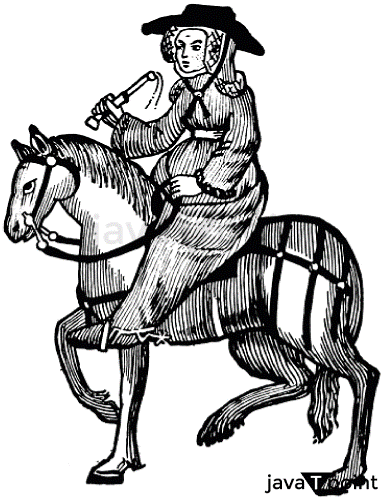
She had always been a deserving lady. Her main claim to fame is that she was married five times, in addition to her numerous relationships when she was younger. She also traveled extensively, stopping at significant shrines in Rome, Bologna, Galicia, and Cologne. She had also visited Jerusalem, although it cannot be said that her trip was purely for religious reasons. "A good man was ther of religioun, ... He taughte, but first he folwed it hymselve." -Line 478-529 Chaucer follows all of these personalities with a decent, religious guy. He was a humble pastor from a little town, yet he had profound spiritual thoughts. Being an academic himself, he was qualified to deliver the gospel. Additionally, he appeared to be preaching to his congregation with sincerity. In terms of his character, he was kind, dynamic, and entirely forgiving under pressure. He was a guy who acted before speaking, and he set an excellent example for his parishioners. The saying "If Gold Gets Rusty, What Will Iron Do?" that he learned from the gospel served as the foundation for his life. Similarly, it makes sense that a commoner would act similarly if a priest did. Because he thought that his duty was to act justly and lead people to paradise, he was intelligent and kind in his preaching. In contrast to many other priests, he had anticipated any formal display of respect. In addition to following what he preached, he also taught the followers the teachings of Christ. "With hym ther was a Plowman, was his brother, ... In a tabard he rood upon a mere." -Line 530-542 Along with him was the Parson's plowman brother. He was sincere and upright, practicing incredible generosity while living in harmony. In every circumstance, including adversity, he loved God. He lived according to the biblical command to love his neighbors as himself. If he had it in his power, he would thrash his grain and aid the underprivileged. He promptly and thoroughly paid his taxes. He rode a mare while wearing a tabard. "Ther was also a Reve and a Millere, ... And therwithal he broghte us out of towne." -Line 543-567 A Reeve, a Miller, a Summoner, a Pardoner, followed by a Manciple, and the poet himself are the other passengers. In all wrestling encounters, the hefty Miler would defeat the ram. He had big shoulders and a short chest. He could pull any door from its hinges or smash it with his skull. He was a clown and a wrangler, which was the most significant kind of immorality and lewdness. He was dressed in a white coat with a blue hood. He had a gift for bagpipe playing. The poet quips in jest that he forced everyone to leave town by playing his bagpipe. 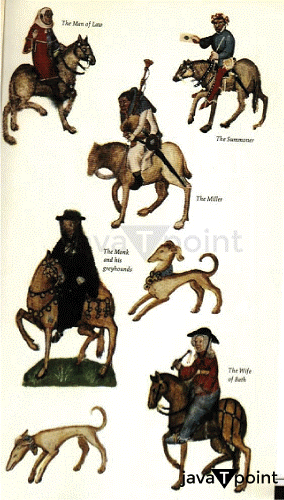
"A gentil Maunciple was ther of a temple, ... And yet this Manciple sette hir aller cappe" - Line 568-587 They were also joined on their ride by this pleasant Maunciple (Manciple) of the Inner Temple (law school). He can teach all consumers how to be discerning purchasers. He was diligent and always struck a good deal, whether he paid cash or used credit to make his purchases. He had several law-savvy, thirsty masters but managed to con them all. He struck wise deals to further his interests. "The Reve was a sclendre colerik man. ... And evere he rood the hyndreste of oure route."- Line 588-624 The farm-bailiff, known as the Reeve, was a short, agitated guy. His hair stood over his ears, and he had shaved his beard as cleanly as possible. He had long, slender legs that looked like staffs. He looked after his bins and garners well. Nobody could outwit him when it came to accounting. He knew how large his crop would be and if there would be rain or drought. He was given full custody of his Lord's property. Everyone in the neighborhood knows his lies and trickery, but they are too terrified of him to say anything about them. He made his Lord proud with his craftsmanship. He rode up on a speckled gray nag and yelled for Scot. He changed into a long, dark blue overcoat and hung a rusted sword at his side. He was seated atop the cavalcade's last horse. "A Somonour was ther with us in that place, ... A bokeleer hadde he maad him of a cake." - Line 625-670 They were accompanied by a summoner with a fiery-red cherub's face with crimson pimples. He had a thin beard, black scabby brows, and was as passionate and lusty as a sparrow. The kids fled away because of his looks. He adored leeks, garlic, and onions. He also liked his wine to be as crimson as blood. Since he would give any man a decent quart of wine for his concubine, Chaucer cynically refers to him as a good fellow. He also has a variety of different strategies at his disposal. Since he knew everyone's secret, he offered to serve as their counselor. He has convinced many people to stop worrying about being shunned by society. He had a spherical cake that was meant to serve as a shield. The summoner considers money everything and thinks wealth can buy one's way out of any situation. "With hym ther rood a gentil Pardoner ... Therefore he song the murierly and loude." -Line 671-716 A Rouncivale pardoner, friend, and colleague arrived with the summoner. He shouted directly from the Roman court, "Come here, love to me!" He had wax-yellow hair that flowed as loosely as a bundle of flax. Unlike others, he had not donned a hood due to his spirit of pride and vitality. He rode unconventionally, sporting a hat over his cape and seeming unkempt. His wallet was stuffed with Roman pardons. He had a few artifacts with him, and by showing them to destitute parsons, he made more significant sums than he could have in two months. He could, after all, sing, tell a tale, and even give a sermon in church. "Now have I toold you shortly, in a clause, ... My wit is short, ye may wel understonde." -Line 717-752 In verse thirty of "The Canterbury Tales: General Prologue," Chaucer concludes how he has portrayed the individuals, including their status, attire, number, and reason for traveling. The Tabard Inn next to The Bell is where they have all assembled. Now he describes how everyone behaved during their initial stay at the Inn. He expects the audience to understand his apologies if he talks simply because he is ready to use their precise words and phrases. It cannot be disputed that Christ made his points clearly throughout the Holy Scriptures. Similarly, as Plato once remarked, "The words should be as a cousin to deed." He also wants his readers to understand if he needs to include the sequence, degree, and aspects of this story related to a social position. He claims to lack wit as well. After that, he began talking about the Host, who had graciously greeted him and all the other visitors that day. " Greet chiere made oure Hoost us everichon, ... Withouten any lenger taryynge." -Line 753-823 The Host appears to be a handsome man who would be an effective marshall in a large hall. He appeared to fit in well with his surroundings and had lively eyes. After dinner, he amused the visitors because he was happy. He now makes his desire to join the group known to the pilgrims. Additionally, he advises them to share two tales on their way to Canterbury and back. He implied that people could avoid boredom in this way. Also, if they ever agree to his concept of storytelling, he offers to be their mentor and an arbiter of their tale. 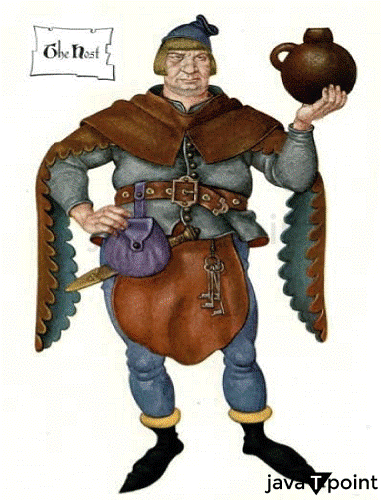
"Amorwe, whan that day gan for to sprynge, ... Ne studieth noght. Ley hond to, every man." - Line 824-843 Their Host woke everyone up the following day and offered to travel with them if they wanted to, should they decide to take him up on his idea. Additionally, he volunteered to be a mediator, an impartial judge, and someone who would listen to their experiences before deciding. The Canterbury party members welcomed his offer and asked him to serve as their impartial judge. They also consented to follow his leadership and instructions. The situation was resolved as a result, and they all quickly retreated. "Anon to drawen every wight bigan, ... His tale anon, and seyde in this man�re." -Line 844-860 Chaucer further explains the Inn Keeper's participation in their voyage in this final prologue section. The following morning, everyone left for Canterbury. The Host kindly reminds guests of their arrangement as they are a short distance from the Inn. He also intends to focus extensively on the passenger names. They all agree that the person picked for the initial drawing will have to take the lead should they decide to proceed by lot. Everyone soon started drawing lots, and the Knight received the first one. It wasn't apparent if it happened by mistake, fate, or chance. They continued their trek toward Canterbury as the Knight began to tell his story when he realized it was his time. The Knight immediately accepted it as if it were a divine order. ConclusionThe whole 14th century is broadly included in the Chaucer Period. It was noteworthy for several notable literary, social, political, and religious activities. Trade and commerce both experienced significant growth. England was also at battle with France and Scotland from 1340 until 1369. The Hundred Year War successes signaled the start of the middle class's rise to power and the end of feudalism. In addition, misconduct in the church reached terrible heights. Chaucer, too, grew up surrounded by medieval literature and ideas, living in a medieval society. Chaucer utilized all of these things collectively as inspiration for his Canterbury Tales.
Next TopicThe Duck and the Kangaroo Summary
|
 For Videos Join Our Youtube Channel: Join Now
For Videos Join Our Youtube Channel: Join Now
Feedback
- Send your Feedback to [email protected]
Help Others, Please Share









